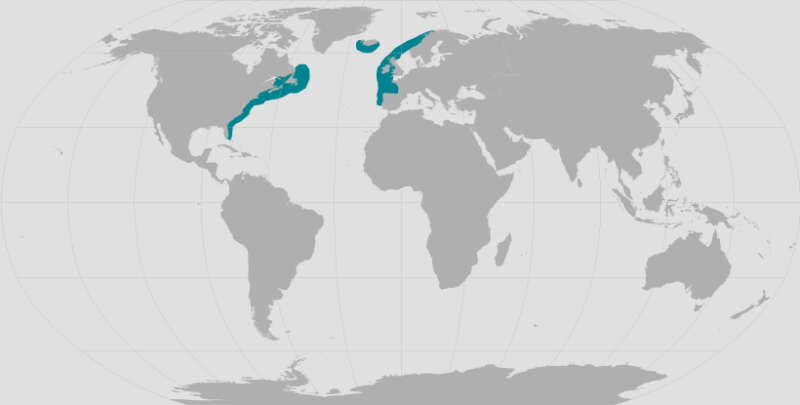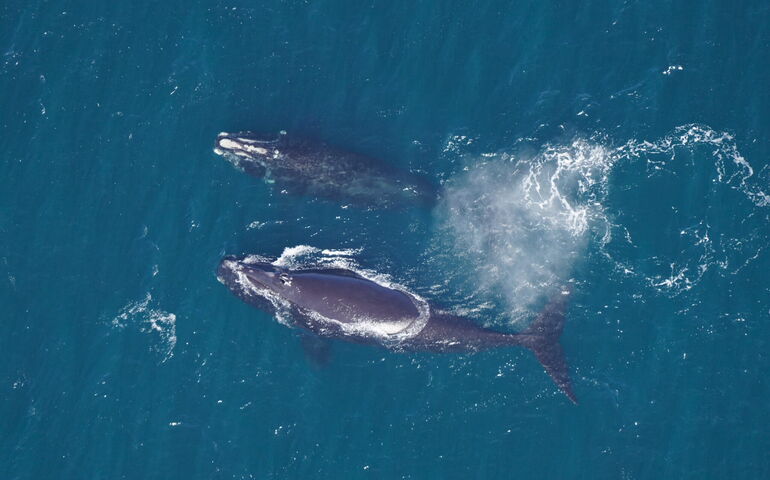
As lobster industry looks to reduce danger to right whales, their decline may be slowing
 Courtesy / New England Aquarium, NOAA
A right whale female named Fission is seen here with an unnamed juvenile male whale during an aerial survey over southern New England waters in March 2023.
Courtesy / New England Aquarium, NOAA
A right whale female named Fission is seen here with an unnamed juvenile male whale during an aerial survey over southern New England waters in March 2023.
The North Atlantic right whale remains endangered, with roughly 360 animals alive at the beginning of 2022 — fewer than a year earlier.
But the population's sharp downward trajectory that started in 2015 might be leveling off, according to the Northeast Fisheries Science Center, a division of the National Oceanic and Atmospheric Administration.
It is too early to know whether the slow-down signals that recovery of the population has started, the center said Monday.
And the critically endangered species still faces significant ongoing threats from human activities, said the Boston-based New England Aquarium, which participates in a consortium of groups that tracks the animal.
Federal regulators estimate that over 85% of right whales have been entangled in fishing gear, including lobster fishing gear, at least once.
In 2021, federal regulators issued a 10-year plan that would have required Maine’s lobster industry to implement a 90% reduction of the risk of fishing gear entanglement.
But the Maine Lobstermen’s Association has said there has never been a right whale death associated with Maine lobster gear, and there hasn't been a single right whale entanglement with Maine lobster gear in nearly two decades.
Earlier this year, the trade association won a lawsuit against the service to invalidate the plan, saying it would eliminate the fishery. Maine lobstermen continue to fish under current whale protection rules while the service develops a new rule.
Other threats to the whale’s survival are vessel strikes, climate change and ocean noise.
Fluctuating estimates
The annual population estimate was made in collaboration with the North Atlantic Right Whale Consortium, using models developed by NOAA and the Anderson Cabot Center for Ocean Life at the New England Aquarium.

The consortium, founded in 1986 as a collaborative data sharing group, shared the latest update at its meeting this week in Halifax, Nova Scotia.
A year ago, the consortium reported that the 2021 estimate was 340 individuals.
But this week’s report said the 2021 estimate was recalculated as 364, primarily due to the 18 calves born in 2021.
The 2022 estimate is 356 animals, although the estimate's range of error means the actual number could be slightly higher or lower.
“While certainly more encouraging than a continued decline, the ‘flattening’ of the population estimate indicates that human activities are killing as many whales as are being born into the population, creating an untenable burden on the species,” said Heather Pettis, a research scientist in the Anderson Cabot Center for Ocean Life at the New England Aquarium and the consortium’s executive administrator.
Two deaths, 32 injuries
There have been two detected deaths of right whales in 2023: a 20-year-old male struck and killed by a vessel and an orphaned newborn calf.
Two documented deaths thus far is considered good news, the consortium said.
However, the group stressed, the news is tempered by research that shows that roughly two-thirds of North Atlantic right whale deaths go undetected.
And human-caused injuries, including gear entanglements and vessel strikes, continue to be a leading cause of the animal’s decline.
“Many of these injuries will likely lead to death, while other injured or sick whales may not be able to reproduce because of their condition,” said Philip Hamilton, senior scientist at the Anderson Cabot Center and the consortium’s identification database curator.
He continued, “This is an important piece of the right whale puzzle. We can’t just focus on [detected] bodies. We must also reduce all injuries that harm this species if they are to turn the corner.”
To date this year, New England Aquarium analysis has detected 32 human-caused injuries to right whales, including six fishing gear entanglements with attached gear, 24 entanglement injuries with no attached gear and two vessel strikes.
Ropeless gear
Aiming to reduce gear entanglements for all whales and other marine animals, efforts are underway to develop ropeless or “on-demand” fishing technology.
Advances in the technology show promise, the aquarium said, but widespread implementation will require significant financial support to escalate the manufacturing of the gear and provide training and support for the fishing industry to adopt gear use.
On-demand, also called “ropeless,” systems use far less rope in the water than traditional gear designs.
To locate and haul gear, traditional methods tether gear to a rope attached to a buoy at the water’s surface. The main characteristic of on-demand gear is that it does not need a gear-to-buoy tether.
Potential alternatives for hauling gear include:
- Pop-up buoys. The vertical line is coiled in a cage that is on the ocean bottom attached to a string of traps. When a signal is received from the boat at the surface, the buoy or cage top is released from the cage. The line uncoils to the surface, allowing the fishing vessel to retrieve the gear.
- Inflatable lift bags. A deflated lift bag is attached to a cage connected to a string of lobster traps. When a signal is sent from the boat, the lift bag inflates and the cage rises to the surface. This allows the fisherman to retrieve the cage and the pots that are connected to it.
- Buoyant spools. Line wrapped around a buoyant spool is tethered to a weight on the bottom. When a signal is sent from the boat, the spool is released. As the spool ascends to the surface, the line unwinds from the spool. It rises to the surface where the fishing vessel can retrieve it, and the gear on the string.
NOAA has developed a “gear library,” housing dozens of on-demand systems from many different manufacturers and available to specially permitted fishermen and researchers to test.
North Atlantic right whales inhabit the ocean's coastal waters, although the animals also are known to travel far offshore. They migrate seasonally and might travel alone or in small groups. In the spring, summer, and into fall, many of the whales can be found in waters off New England and further north into Canadian waters, where they feed and mate.
Each fall, some right whales travel more than 1,000 miles from these feeding grounds to the shallow, coastal waters of their calving grounds off of South Carolina, Georgia, and northeastern Florida.










0 Comments